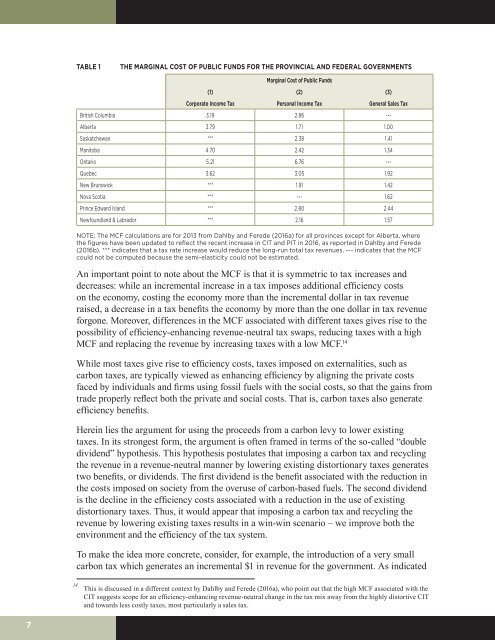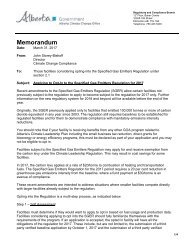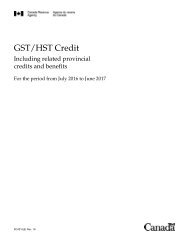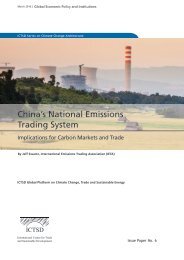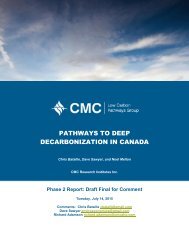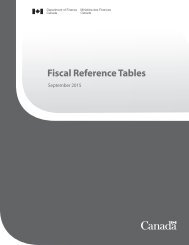MAKE THE ALBERTA CARBON LEVY REVENUE NEUTRAL
carbon-levy-revenue-neutral-mckenzie
carbon-levy-revenue-neutral-mckenzie
You also want an ePaper? Increase the reach of your titles
YUMPU automatically turns print PDFs into web optimized ePapers that Google loves.
TABLE 1<br />
<strong>THE</strong> MARGINAL COST OF PUBLIC FUNDS FOR <strong>THE</strong> PROVINCIAL AND FEDERAL GOVERNMENTS<br />
Marginal Cost of Public Funds<br />
(1) (2) (3)<br />
Corporate Income Tax Personal Income Tax General Sales Tax<br />
British Columbia 3.19 2.86 ---<br />
Alberta 3.79 1.71 1.00<br />
Saskatchewan *** 2.38 1.41<br />
Manitoba 4.70 2.42 1.34<br />
Ontario 5.21 6.76 ---<br />
Quebec 3.62 3.05 1.92<br />
New Brunswick *** 1.91 1.42<br />
Nova Scotia *** --- 1.62<br />
Prince Edward Island *** 2.80 2.44<br />
Newfoundland & Labrador *** 2.16 1.57<br />
NOTE: The MCF calculations are for 2013 from Dahlby and Ferede (2016a) for all provinces except for Alberta, where<br />
the figures have been updated to reflect the recent increase in CIT and PIT in 2016, as reported in Dahlby and Ferede<br />
(2016b). *** indicates that a tax rate increase would reduce the long-run total tax revenues. --- indicates that the MCF<br />
could not be computed because the semi-elasticity could not be estimated.<br />
An important point to note about the MCF is that it is symmetric to tax increases and<br />
decreases: while an incremental increase in a tax imposes additional efficiency costs<br />
on the economy, costing the economy more than the incremental dollar in tax revenue<br />
raised, a decrease in a tax benefits the economy by more than the one dollar in tax revenue<br />
forgone. Moreover, differences in the MCF associated with different taxes gives rise to the<br />
possibility of efficiency-enhancing revenue-neutral tax swaps, reducing taxes with a high<br />
MCF and replacing the revenue by increasing taxes with a low MCF. 14<br />
While most taxes give rise to efficiency costs, taxes imposed on externalities, such as<br />
carbon taxes, are typically viewed as enhancing efficiency by aligning the private costs<br />
faced by individuals and firms using fossil fuels with the social costs, so that the gains from<br />
trade properly reflect both the private and social costs. That is, carbon taxes also generate<br />
efficiency benefits.<br />
Herein lies the argument for using the proceeds from a carbon levy to lower existing<br />
taxes. In its strongest form, the argument is often framed in terms of the so-called “double<br />
dividend” hypothesis. This hypothesis postulates that imposing a carbon tax and recycling<br />
the revenue in a revenue-neutral manner by lowering existing distortionary taxes generates<br />
two benefits, or dividends. The first dividend is the benefit associated with the reduction in<br />
the costs imposed on society from the overuse of carbon-based fuels. The second dividend<br />
is the decline in the efficiency costs associated with a reduction in the use of existing<br />
distortionary taxes. Thus, it would appear that imposing a carbon tax and recycling the<br />
revenue by lowering existing taxes results in a win-win scenario – we improve both the<br />
environment and the efficiency of the tax system.<br />
To make the idea more concrete, consider, for example, the introduction of a very small<br />
carbon tax which generates an incremental $1 in revenue for the government. As indicated<br />
14<br />
This is discussed in a different context by Dahlby and Ferede (2016a), who point out that the high MCF associated with the<br />
CIT suggests scope for an efficiency-enhancing revenue-neutral change in the tax mix away from the highly distortive CIT<br />
and towards less costly taxes, most particularly a sales tax.<br />
7


